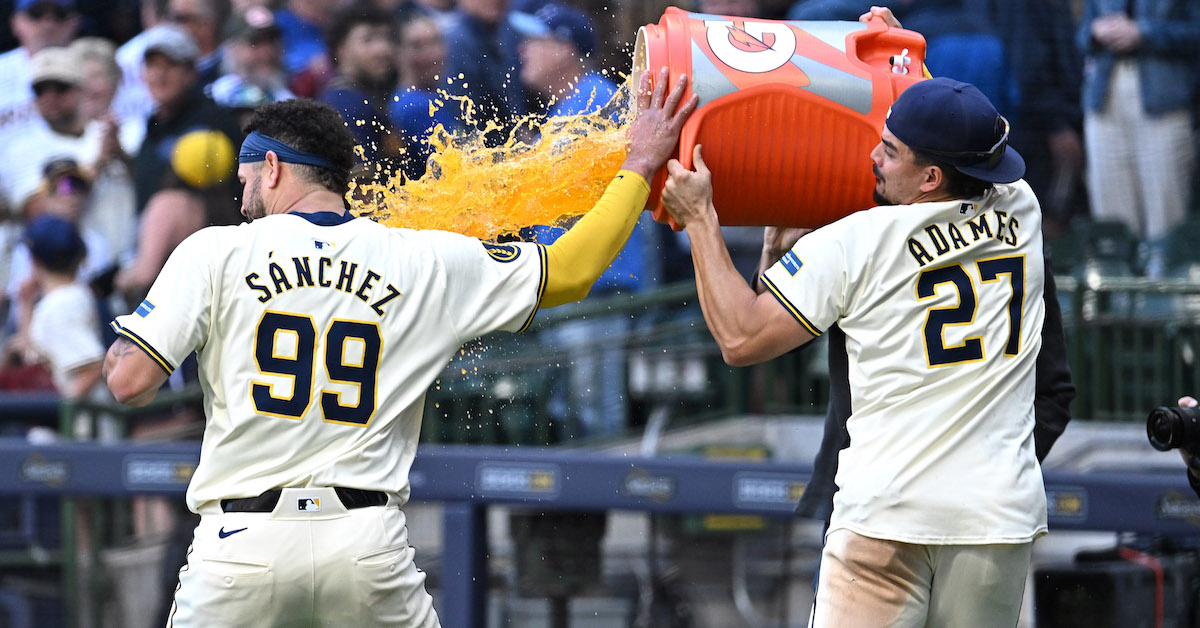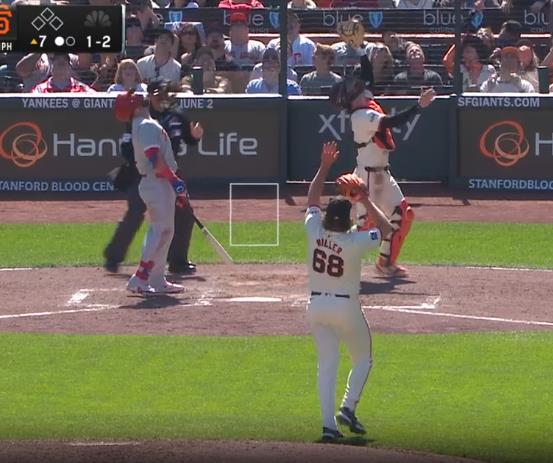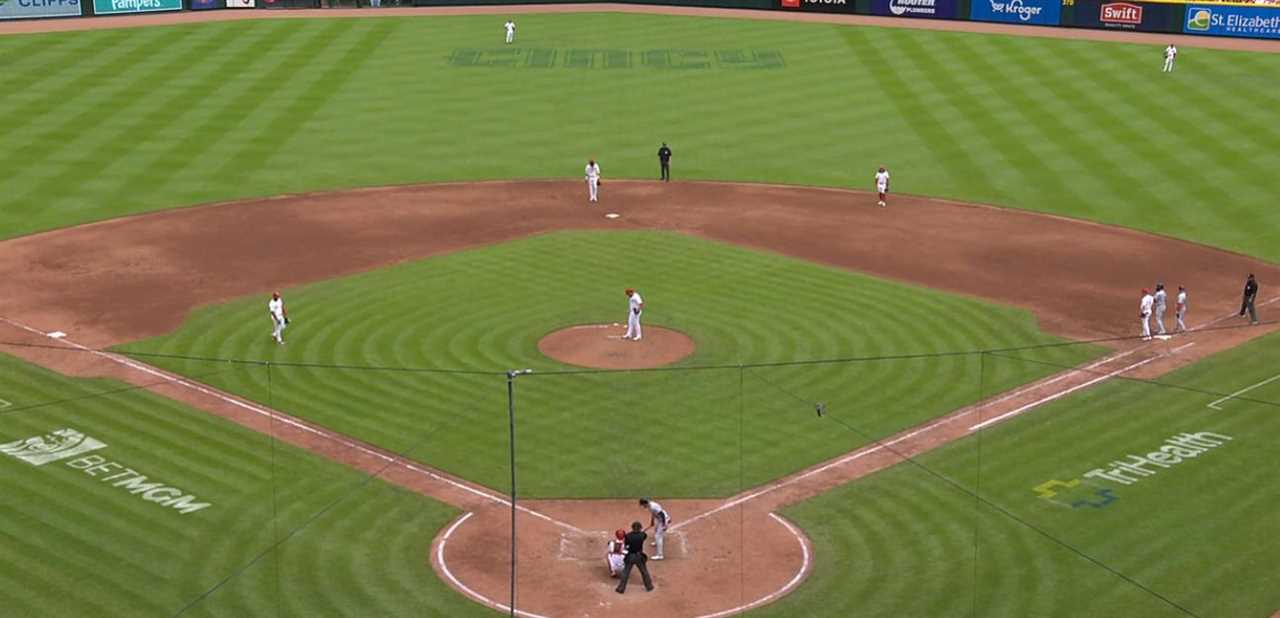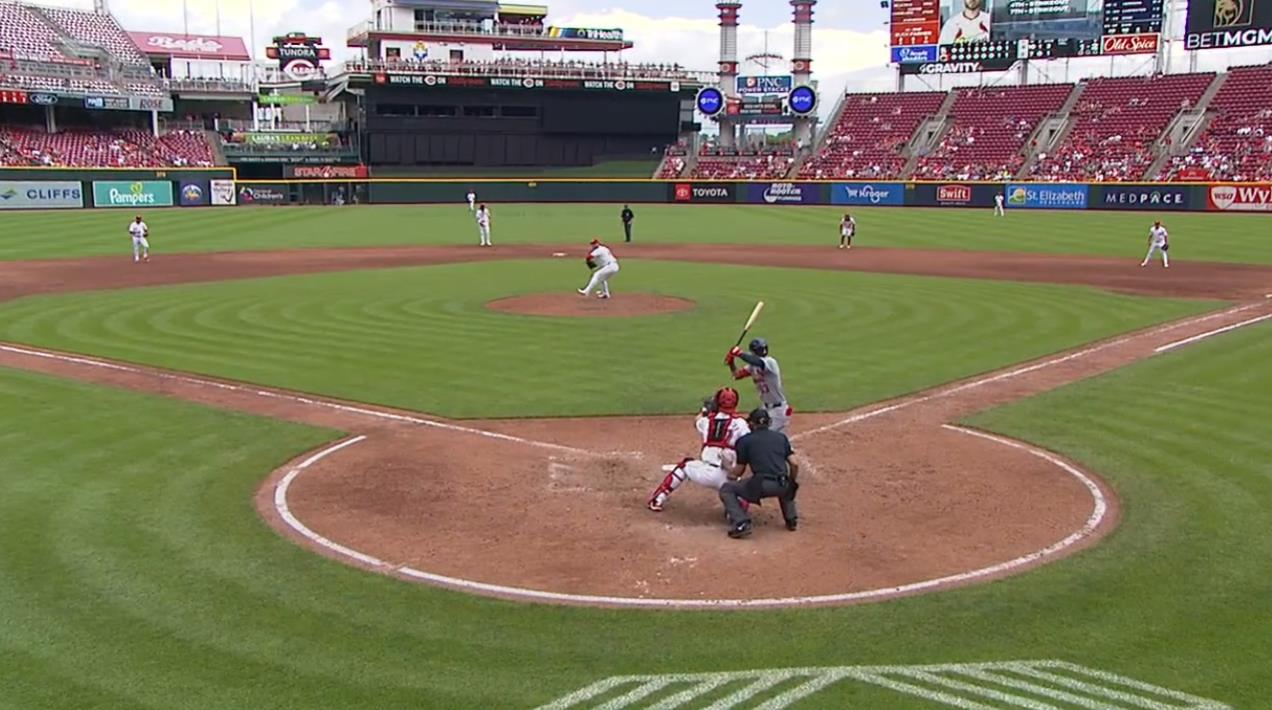
Michael McLoone-USA TODAY Sports
Welcome to another edition of Five Things I Liked (Or Didn’t Like) This Week. I’m not sure that Zach Lowe, the progenitor of this format and an incredible NBA writer, ever thought that it would get spun off into baseball. I’m certain that he didn’t think it would get spun off into baseball by someone who likes both popups and bunts an unhealthy amount. But here we are. Speaking of which, I know what you’re thinking: What does Ben think about the two catcher’s interference infield flies from this week? I thought they were more annoying than amusing, and that’s not what we’re about here at Five Things. So let’s talk about a far more delightful popup, plus some infield hits, pretty pitches, and exciting series.
1. A Schwarbloop
Kyle Schwarber hits majestic home runs. Sometimes they hang in the air for an improbable length of time. Sometimes they get out of the park before you can blink. Not only is there a name for them – Schwarbombs – but Wawa even makes a drink named after them. You can’t get any more Philadelphia than that.
Schwarber hit one of those magnificent bombs he’s known for on Monday. Boy, did that thing take off:
But whatever. That’s boring! He hits a lot of homers. I want to talk about his single that went farther upward than it did forward and ended up behind home plate:
That’s a colossal blast of a short popup. The afternoon sun in San Francisco is merciless, too, which explains how the fielders looked like this:

That ball might as well have been invisible, for all the luck Patrick Bailey and Erik Miller had in finding it. It only narrowly avoided clocking Miller on its way down. Matt Chapman was theoretically in charge, but he wasn’t really. He just got less blinded than the other two and tried to make the best of a bad situation.
Amazingly, the gusting wind took command and turned the ball back in toward home plate. By the time it hit the ground, with three Giants helplessly converging around it, the momentum had turned squarely toward foul territory:
Through his legs! That’s truly remarkable. Schwarber hit the ball way up in the air and out in front of home plate, and he and the wind combined to roll it right back over the plate after touching down fair:
I can understand how this is theoretically possible. Almost all of the force Schwarber imparted into the ball was directed straight up, so the forward velocity of the ball was quickly killed by the wind, and then the wind started pushing it backward on that plane. By the time it hit the ground, it was headed backward.
That’s the mathematical explanation, but let me put it this way: You could play a baseball-themed version of HORSE all day and never hit that shot. “High pop, land it 15 feet fair, curl it back foul behind home plate, through the catcher’s legs.” It’s the baseball equivalent of bouncing one off the floor, off the backboard, and then off the rim and in.
Should it have been a hit? Eh, probably not. It doesn’t look like Bailey touched it before it rolled foul, though I’m hardly certain:
But it’s not reviewable, and to be honest with you, I didn’t want it to be reviewed. That should count as a hit on degree of difficulty alone. It’s the least likely thing I saw all week, maybe all year.
2. The Counsell Bowl
The Cubs and Brewers had already played in Chicago this year, but the first meeting in Milwaukee was circled on everyone’s calendar. Craig Counsell managed the Brewers for nine years and oversaw their ascent to a perennial playoff contender and one of the best-run franchises in baseball. Then he left, for a division rival no less.
The team played a tribute video before the first game of the series, but fans booed Counsell anyway. I don’t blame them; give it a few years, and I’m sure the good memories will overwhelm the sting of betrayal, but seeing your guy in their colors for the first time is always going to engender some boos.
That aside, this series had everything, and I’m excited for this rivalry, already a hotly contested one, to become one of the best in baseball for the next few years. These games were tense. Justin Steele and Robert Gasser pitched to a scoreless tie on Monday, and when Gasser flagged, the Brewer ’pen picked him up, like it did for so many years under Counsell. The Cubs relievers… yeah, they did not do that. Mark Leiter Jr. and Hayden Wesneski came in and gave up two walks and three hits, including a back-breaking Willy Adames home run, to turn a close game into a laugher.
Adames was nearly the hero again the next day, when he broke through against yet another high-leverage Cubs reliever, Héctor Neris, with two outs in the bottom of the ninth. His game-tying single rendered Ben Brown’s seven no-hit innings irrelevant and briefly put the Brewers back in the driver’s seat.
The Cubs bullpen has been awful this year; their relievers have a 4.48 ERA, and their closer has as many walks as strikeouts. But their starters keep putting them in a position to win, and on Tuesday, the offense came through with a five-run outburst in the 10th. There were high tensions, assistant pitching coach ejections (Neris had a controversial balk that put a runner in scoring position for Adames), and big defensive plays.
After coming up empty against Steele and Brown, the Brewers offense exploded for seven runs against Cubs ace Shota Imanaga on Wednesday. Adames, as he always seems to be, was in the middle of it. The Milwaukee crowd went wild. The Brewers closed out the series yesterday by taking down Chicago’s bullpen yet again; after the Cubs rallied to tie the game 4-4 in the eighth, Luke Little and Tyson Miller combined to yield two runs and the game. Miller, who relieved Little with two outs and Christian Yelich on third, promptly surrendered the decisive blast, a two-run Gary Sánchez home run.
It’s tough to imagine that every series these two teams play this year will be so electric. Counsell’s first return to Milwaukee was always going to be an event, and the teams being in first and second place at the time added to it. Three of the four games were tied late, and the other featured one of the most exciting pitchers in the game getting tattooed by the home team. This is 2000s-era Yankees/Red Sox stuff, two good teams whose fans don’t like each other, with Counsell’s defection upping the stakes for Milwaukee, a city that often feels big-brothered by nearby Chicago. The two teams play only six more times this year, and hearing that, I find myself longing for the 19-games-vs.-each-divisional-opponent schedule to come back so we can see more games like these.
3. Brilliant Baserunning
One item wasn’t enough to capture that magnificent series. Cubs rookie Luis Vazquez has batted only once in the majors, and he struck out on four pitches and three swings at breaking balls in the dirt. He’s organizational depth the team hopes not to have to use, and in fact they’ve already sent him back to the minors. In Tuesday’s game, however, he showed off the kind of baseball IQ that you can’t teach.
Guys like Vazquez don’t normally get into high-leverage games, but catcher Miguel Amaya was the designated runner for Chicago in the top of the 10th, and that sounds like a job for Vazquez.
Mike Tauchman, the first Cubs batter of the inning, lined a comebacker to Brewers closer Trevor Megill.
Then, chaos ensued:
First things first: I hope Megill is OK. He seems set to avoid an IL stint and only has a bruise to show for it. But it was surely a nasty bruise. Tauchman hit that ball hard and right into Megill’s forearm. He immediately recoiled in pain; there was no way he was fielding it:
Poor William Contreras was in a bind. He couldn’t go out and get the ball, obviously; you can’t run 50-ish feet in catcher’s gear, pick up a ball, change directions, and make it back home faster than a speedy runner already rounding third. The math just doesn’t work. Abandon home plate, and the run scores. All Contreras could do was point and hope that Vazquez didn’t realize the predicament:
Vazquez realized it. He was coasting until he got to third, keeping his eye on the play and doing his job by getting a base closer to scoring. Then he did the math and hit the jets:
Every single Brewers fielder was caught between obligations. The corner infielders had runners headed for their bases; they were more or less rooted to the spot when they saw the ball hit Megill, because if he recovered to field it, they needed to be in position to receive a throw. Adames headed to second in case the line drive got through, then stayed there because someone needed to stop Tauchman from getting a free base. Brice Turang had started the play a step in front of the outfield grass, so he surely wasn’t part of any plan for who should field a ball at the pitcher’s mound.
Perhaps someone missed an assignment; maybe Turang should have crashed for second while Adames charged the mound or something like that. Maybe Owen Miller should have abandoned first base as soon as he saw Megill hopping off, giving up on recording an out to secure the baseball. But none of those plays made much sense in the moment. Instead, everyone just pointed:
The logic is simple: If the ball hits the pitcher and then squirts away toward a fielder, it’s now that fielder’s responsibility, with either the pitcher or another fielder replacing them. But Megill was in no position to replace anyone, and the only fielder the ball was even remotely near was Contreras, who also happened to have the least abandonable base. The Brewers simply had no good plays.
With a less alert runner (or base coach), it might not have mattered. Miller actually gave up on Tauchman fairly quickly and went for the ball. But Vazquez put the pieces together more quickly and realized he could score. So he did. A slower initial break might have left him out of position to score. A more conservative base coach might have screamed at him to stop. A more aggressive defense might have limited the damage to runners on first and third. But none of that happened, and Vazquez capitalized.
This play ended up mattering far more because it knocked Megill out of the game than because Vazquez scored. As I mentioned up above, the Cubs scored five runs in the inning. Any number of hits and walks would have driven a runner in from third. But that doesn’t change the brilliance of the play. Taking every risk-free base the other team gives you is a key part of baserunning, and this was an incredible, albeit unorthodox, example of what it looks like at its best.
4. GrayRod’s Right/Right Changeup
I’m a simple man. I like the finer pleasures in life. A nice hot coffee in the morning, a nice cold lemonade in the afternoon, a nice dinner in the evening, and right-on-right changeups thrown with impeccable command:
Oh my goodness, these are fun. Grayson Rodriguez has an embarrassment of riches when it comes to pitch quality, but his changeup is probably his best. He uses it most frequently against lefties, nearly a third of the time, and that’s just good pitching strategy. He has a nasty slider, somewhere between gyro and sweeper, that righties struggle to deal with. He shelves that against lefties, of course, but he’s largely fastball/slider to righties.
That’s how changeups get used across all of baseball. It’s a shape thing, basically; slow pitches that break toward righties don’t work well if they aren’t located well, so pitchers opt for better options instead. But if you have a cambio as good as Rodriguez’s, it would be a waste to completely give it up just because of pesky platoon issues.
He doesn’t break it out often, but when he does, it’s frequently a thing of beauty. That pitch to Vaughn Grissom looked hittable right until it took a sharp turn downward. In-breaking movement? Sure, maybe, but that doesn’t matter when the batter swings over it by a foot.
It’s a great tool for dealing with hitters who cover his fastball and aren’t biting on the slider. Julio Rodríguez has been heating up, but he was no match for this diving change:
That pitch is a great out pitch, and that’s the way that Rodriguez most frequently gets righties with the changeup. But his command with it is good enough that he can back-door it for a strike too:
Sometimes, he can tuck it in the zone with enough action to miss a bat anyway:
This is never going to be more than an occasional mix-in. The fastball/slider combo is just too good, and he even has a plus curveball for a down-breaking option if the slider isn’t working. But what an option to have! Rodriguez looks like he’s fulfilling the promise he showed as a prospect, and these changeup punctuation marks are a big part of it.
5. Death-Defying Bunts
Major leaguers have attempted nine bunts in two-strike counts this year. They’ve gone predictably poorly. Four have ended in foul bunt strikeouts. One ended with a swinging bunt strikeout, and yes, it’s as embarrassing as it sounds:
Another one ended in absolute madness:
There’s a ton to unpack on that play, like whether it made sense for Vladimir Guerrero Jr. to play the ball fair and try for the out at home. But that’s not why I’m writing about this today, so let’s keep going. Another two two-strike bunts have turned into successful sacrifices. The ninth? Well, that one happened on Wednesday, and that’s why I’m writing this item:
Was that a good plan? I actually think it was. Michael Siani had already bunted a ball foul earlier in this at-bat, when he was trying to advance Masyn Winn to second. The Reds were so worried about Winn that they called a pitchout, even. But Winn tried to steal second on 1-1 and got caught. That left Siani in a 1-2 hole, and the defense moved back accordingly. Jeimer Candelario had been playing outrageously close at the start of the at-bat:

That’s a pretty unfriendly defensive alignment, and Siani’s foul bunt was pushed down the first base line. But with no runner on and two strikes, Candelario moved from crashing to playing where the shortstop normally lines up:

You’re just not gonna get a better defensive alignment to attack with a bunt than that. The whole expanse of grass by third base is open for the taking! A ball anywhere in that general vicinity is probably going to land. And not to put too fine of a point on it, but Siani is a bad hitter. He has a 61 wRC+ this year, with a pile of strikeouts and few extra-base hits or walks. He was in a 1-2 hole. This movie usually doesn’t end well for the batter.
The question, then, is whether Siani could keep the ball fair. He really didn’t need to do anything more than that against this gaping-void style of defense:
If you think that a fair bunt will result in a hit half the time, the numbers actually support his decision. He’s laid down 16 bunts this year; 10 have been fair and six have been foul. In the majors, he has a .244 OBP after a 1-2 count; five out of 16 works out to .313. More broadly, he has a career .248 OBP overall, and we project him for a .293 mark the rest of the way. This is the kind of chance you can’t pass up if you’re a good bunter getting played passively. By the same token, the Reds were too casual with their defense here. I’m not sure how many outs they pick up in the long run with the near-overshift they deployed, but it can’t be enough to offset the fact that they’re letting a poor hitter in a bad count bunt his way on. It’s one thing to shift against a terrifying slugger, and a different thing entirely to shift against the major league leader in sacrifice bunts.
Is Siani the long-term solution for the Cardinals in center? Probably not. He’s a brilliant defender, but the guy really can’t hit major league pitching. I hope I’m wrong, though, because he’s a blast to watch both in the field and on the basepaths. More well-considered bunts like this one will certainly help.
Source
https://blogs.fangraphs.com/five-things-i-liked-or-didnt-like-this-week-may-31/
 Backyard GrillingWeekend WarriorsAdvice from DadBeard GroomingTV Shows for Guys4x4 Off-Road CarsMens FashionSports NewsAncient Archeology World NewsPrivacy PolicyTerms And Conditions
Backyard GrillingWeekend WarriorsAdvice from DadBeard GroomingTV Shows for Guys4x4 Off-Road CarsMens FashionSports NewsAncient Archeology World NewsPrivacy PolicyTerms And Conditions
